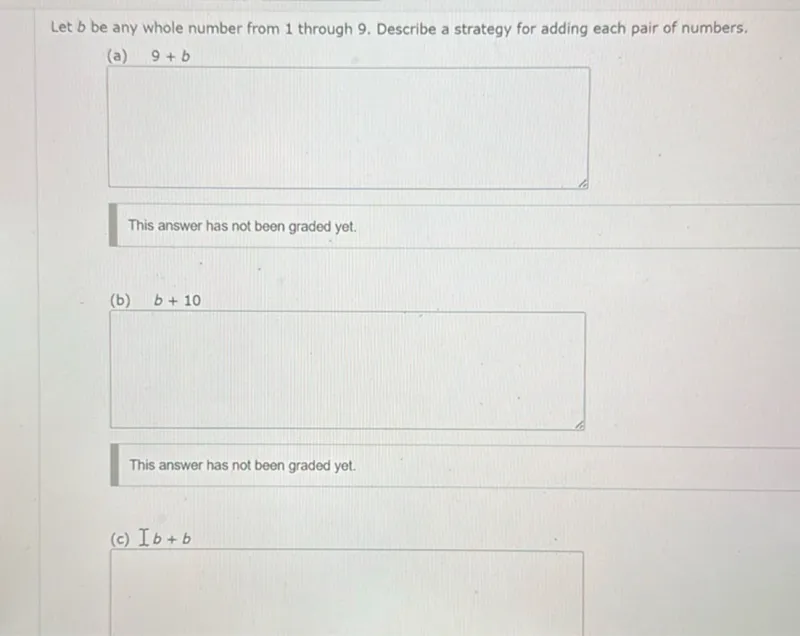I'll solve this algebra problem step by step, following the strategy for adding each pair of numbers.
For part (a), I need to find a strategy for adding $9+b$ where $b$ is any whole number from 1 through 9.
Identify the pattern when adding 9 to a single digit
When we add 9 to any single digit number $b$, we can use the fact that $9 = 10 - 1$. So $9 + b = (10 - 1) + b = 10 + b - 1$.
Apply the pattern to find a simple strategy
Since $10 + b$ gives a number where the tens digit is 1 and the ones digit is $b$, subtracting 1 from this result means the tens digit remains 1 but the ones digit becomes $b-1$.
Therefore, when adding $9 + b$, the result will always have:
- A tens digit of 1
- A ones digit of $b-1$
For example:
- $9 + 1 = 10$ (tens digit: 1, ones digit: 0 = 1-1)
- $9 + 2 = 11$ (tens digit: 1, ones digit: 1 = 2-1)
- $9 + 9 = 18$ (tens digit: 1, ones digit: 8 = 9-1)
\(\boxed{\text{Strategy for }9+b\text{: The result will have a tens digit of 1 and a ones digit of }b-1}\)
For part (b), I need to find a strategy for adding $b+10$ where $b$ is any whole number from 1 through 9.
Analyze the pattern when adding 10 to a single digit
When we add 10 to any number, we're simply increasing the tens place by 1 while keeping the ones place the same.
Formulate the strategy
For $b + 10$ where $b$ is a single digit (1 through 9):
- The tens digit will be 1
- The ones digit will be $b$
For example:
- $1 + 10 = 11$ (tens digit: 1, ones digit: 1)
- $5 + 10 = 15$ (tens digit: 1, ones digit: 5)
- $9 + 10 = 19$ (tens digit: 1, ones digit: 9)
\(\boxed{\text{Strategy for }b+10\text{: The result will have a tens digit of 1 and a ones digit equal to }b}\)
For part (c), I need to find a strategy for adding $Ib+b$ where $b$ is any whole number from 1 through 9.
Interpret what $Ib$ means
I understand $Ib$ to mean the two-digit number where $I$ represents 1 in the tens place and $b$ is in the ones place. So $Ib = 10 + b$.
Determine the strategy for adding $Ib+b$
We need to add $(10 + b) + b = 10 + 2b$.
This means:
- If $2b < 10$ (when $b < 5$), the result will be a two-digit number with 1 in the tens place and $2b$ in the ones place.
- If $2b \geq 10$ (when $b \geq 5$), the result will be a two-digit number with 2 in the tens place and $(2b - 10)$ in the ones place.
For example:
- When $b = 3$: $13 + 3 = 16$ (tens digit: 1, ones digit: 6 = 2×3)
- When $b = 7$: $17 + 7 = 24$ (tens digit: 2, ones digit: 4 = 2×7-10)
\(\boxed{\text{Strategy for }Ib+b\text{: The result will be }10+2b\text{, which equals }1\text{ in tens place and }2b\text{ in ones place when }b<5\text{, or }2\text{ in tens place and }2b-10\text{ in ones place when }b\geq5}\)
\(\boxed{\text{Strategy for }9+b\text{: The result will have a tens digit of 1 and a ones digit of }b-1}\)
\(\boxed{\text{Strategy for }b+10\text{: The result will have a tens digit of 1 and a ones digit equal to }b}\)
\(\boxed{\text{Strategy for }Ib+b\text{: The result will be }10+2b\text{, which equals }1\text{ in tens place and }2b\text{ in ones place when }b<5\text{, or }2\text{ in tens place and }2b-10\text{ in ones place when }b\geq5}\)






